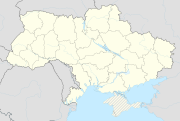Shorany
| Shorany | ||
| Згорани | ||

|
|
|
| Basic data | ||
|---|---|---|
| Oblast : | Volyn Oblast | |
| Rajon : | Lyuboml district | |
| Height : | 172 m | |
| Area : | 3.0 km² | |
| Residents : | 1,381 (2001) | |
| Population density : | 460 inhabitants per km² | |
| Postcodes : | 44313 | |
| Area code : | +380 3377 | |
| Geographic location : | 51 ° 22 ' N , 23 ° 59' E | |
| KOATUU : | 0723382201 | |
| Administrative structure : | 4 villages | |
| Mayor : | Serhiy Levchuk | |
| Address: | 44313 c. Згорани | |
| Statistical information | ||
|
|
||
Shorany (Ukrainian Згорани ; Russian Згораны / Sgorany , Polish Zgorany ) is a Ukrainian village in the oblast Wolyn . It is located in the Ljuboml district , about 16 kilometers northwest of the district capital Ljuboml and about 117 kilometers northwest of the Oblast capital Lutsk on the Nerescha river. Administratively, the place forms together with the villages Hupaly (Гупали), Sylne (Сильне) and Saoserne (Заозерне) the district council of Shorany.
The village was mentioned in writing in 1674 for the first time and belonged to the third partition of Poland the nobility Republic of Poland (in the province of Ruthenia / Chelmer country), then came to the Russian Empire , where the government Volyn was. In 1918/1921 it fell to Poland and came to the Volyn Voivodeship in the Powiat Luboml , Gmina Zgorany . As a result of the Hitler-Stalin Pact , the Soviet Union occupied the area and made the place the capital of the Shorany district of the same name in January 1940 , but in the same year the administration was moved to Holowne and Shorany remained a simple village. After the German invasion of the Soviet Union in June 1941, the place was under German rule until 1944 (in the Reichskommissariat Ukraine ), came back to the Soviet Union after the Second World War , was incorporated into the Ukrainian SSR and has been part of today's Ukraine since 1991.
North of the village are the Great Shorany Lake and the Small Shorany Lake .



